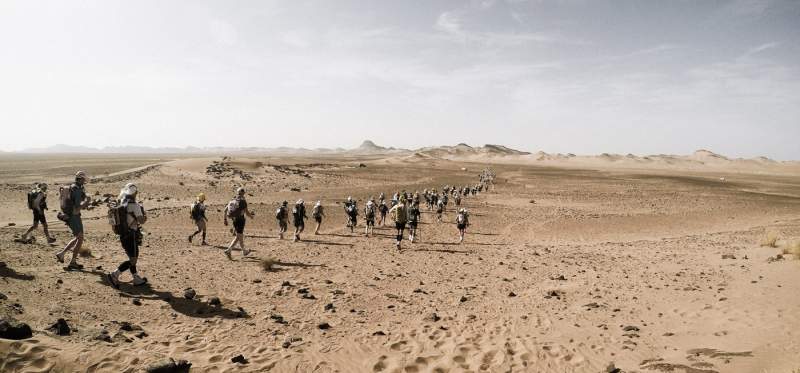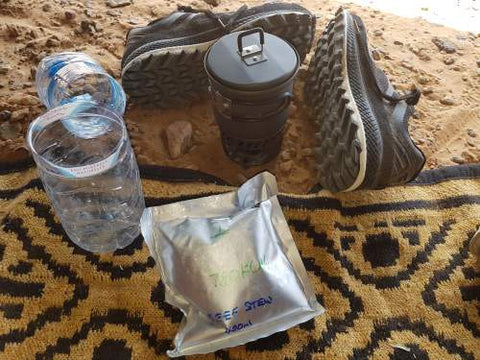
Running an ultramarathon
Ultramarathons, once described as “the reclusive, funky-smelling cousin of traditional road racing” by the Washington Post, are now the peak of ambition for long-distance runners. The number of races has increased 1,000% over the past decade, with new desert trail and mountain routes springing up each year. Any run greater than a standard marathon, at 26.2 miles, is considered an ultramarathon. Many are much longer, taking upwards of a week to complete. Despite entries costing in their thousands, races often sell out within minutes.
To an outside spectator, ultramarathons can seem baffling. With the amount of training involved, the physical and mental anguish, the financial costs and the sheer distances that need to be covered, it’s curious why anyone would want to make the attempt. To find out, we speak to some of the planet’s toughest ultra runners, each one fuelled by FIREPOT.
Here, five things every runner should know before taking part in an ultramarathon, as told to us by experts.

Training is vital: “The phrase ‘train hard, fight easy’ does work,” says runner Pete Newland, who took part in the 6633 Arctic Ultra — a 350-mile foot race in temperatures hitting 50 below. “The more you get used to being out of your comfort zone, the easier ultra endurance events are.” Before big races, Newland trains six days a week, running up to 30 miles each day. This is common, among ultra runners, with the distance of a full marathon just a normal run in their weekly training calendar.
However, it’s not just the physical endurance that requires work. Paratrooper Andrew Stewart, who took part in the Marathon des Sables, equivalent to running six marathons in six days across the Sahara desert, says the climate is the hardest part to prepare for. Before the MDS, he trained in layer upon layer of fleecing, cranking the heat in his gym right up in an attempt to simulate the desert.

Choose your food wisely: In his book Born to Run, athlete Christopher McDougall says ultramarathons are “eating and drinking contests with a little exercise and scenery thrown in.” While that might not be quite true, runners do spend the majority of their time snacking on dried fruit, chocolate and energy gels, forcing something down at least every two hours to avoid energy depletion. Charlie Newington-Bridges, who recently finished the 'Marathon des Salmon' in Wales, says food is one of the biggest perks: “There are very few comforts when running ultras, so finishing the day with a good meal is incredibly uplifting.”
Weight is also a huge factor for runners. “When you’re carrying it all on your back, every gram counts,” says Tim Treloar, founder of TTAdventures. Like many athletes, he removes his freeze-dried food from its original pouch and repackages it before the race, because even those extra 20 grams (less than the weight of an AA battery) make a difference — especially when you’re consuming upwards of 7,000 calories a day.

Custom packaging for the MDS race
Running is a game of mind more than body: “The mind is the biggest failure for most,” says Newland. “It’s like you have two devils on your shoulder, one telling you to crack on and the other telling you it’s not worth it. The bad devil appears in every race, urging you to give up. It’s a battle to get rid of him.” Sleep deprivation doesn’t help. On non-stop races like the 6633 Arctic Ultra, you can only sleep 40 minutes every 24 hours if you want to finish. Newland describes the dizziness, disorientation and wild hallucinations he’s had running, from dead people floating beneath the ice road, to men shouting at him from the side of the path. “I can deal with the physical pain,” he says, “but lack of sleep is a killer and changes every plan you have to complete a race.” To stay alert, he repeats the alphabet backwards, which helps the brain concentrate and stops the waves of sleep attack, where he literally falls asleep standing up.
Jamie Ramsay — a runner who once ran 10,000 miles, from Canada to South America — says it is important to concentrate on the finish line. In a recent ultramarathon, he listened to the same playlist over and over for eight days to stay focused. “It was my metronome, taking a step forward on each beat. I remind myself that others will be flirting with the temptation to stop, and that I can’t be like them.” To distract himself from the monotony, he plays games. “I’ll try and work out the number steps between telegraph poles. I’ll do sums about how far I’ve run and how quickly I can finish. It’s all a form of distraction.”

It will hurt, but you can push through: Ultrarunners face a variety of ailments during a race, including extreme blisters, chafing, blurred vision, heart problems, dehydration, hypothermia and stress fractures. Cramping is also very common, caused by a lack of electrolytes due to mediocre nutrition.
Interestingly, ultrarunners might be more equipped at handling pain than the average person. In a recent study at Monash University in Australia, researchers found that ultrarunners could keep their arms in icy water for far longer than the control group, and reported less pain when asked to rate themselves on an 11-point scale. This led them to conclude that ultrarunners have reduced pain ‘attention’ and may think about pain in a distinct way from the rest of the population.
Jamie Ramsay might be a good example of this. In his recent 400km Cape Wrath Ultra, he pushed himself hard, spraining and twisting both ankles, and damaging his shin. “The pain was intense and resulted in a lot of discomfort. But knowing my performance would suffer gave me the mental strength to continue. You can stop at anytime but it’s that determination to push on that defines you as a runner.” After finishing third in the race, he had to visit the hospital for X-rays and spent three weeks on crutches.

It’s worth it when you hit the finish line: After reading how gruelling ultras can be, it’s hard to imagine why runners keep going back. But most say the same thing — running is euphoric. In fact, recent findings suggest running can be akin to the high of heroin, with the endorphins producing morphine-like reactions in the brain. When this is added to the accomplishment of finishing a race — especially one which has been so incomprehensibly challenging — it creates an even greater sense of euphoria.
Newington-Bridges puts finishing his recent ultramarathon as one of the happiest moments of his life. “It’s up there with the birth of my child and marriage,” he says. “It’s difficult to explain, but the intensity of the pleasure is very addictive.” Pete Newland says something similar: “Ultras are expensive, they hurt, and they push you to the absolute edge, but it’s worth it ten times over when you cross that finish line.”
Final tips from our experts- Plan for blisters, regardless of how good you think your feet are. Practice taping your feet and cutting the tape correctly, and make sure you tape your feet before the race — prevention is way better than a cure. You can be the ultimate warrior, but if you get blisters, you’re not going anywhere fast.
- The tortoise beats the hare. Walking is encouraged, especially because races usually go on for days, with very few spectators to judge your speed.
- You have to be hyper-aware of the tiniest things, like rubbing straps or a small stone in your shoe. Left unattended, these things grow into a race-ending injuries over the miles ahead.
- Design a playlist — music breaks up the monotony.
- Make sure you have the correct shoes for the terrain you’re running in, and change your trainers every four to six months.
- Chafing can be a showstopper. Vaseline and talcum powder are packing essentials.

